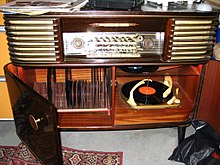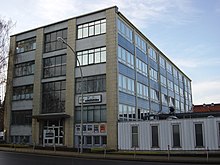Cuba Imperial
The company Kuba-Imperial (also Kuba) was a manufacturer of "clay furniture", later also television sets, which at that time were also called " brown goods ". The entertainment electronics company based in Wolfenbüttel existed from 1948 to 1972 and operated under several names.
Sound furniture or music chests were combinations of radio and record player in a stylish wooden housing, which at the time also represented a status symbol as a furnishing item . In the more expensive models, a tape recorder and / or ( black and white ) television set was also integrated.
history

Gerhard Kubetschek founded the sound furniture company Kuba in 1948, which in 1949 had sales of one million German marks (DM). The company grew rapidly during the economic miracle and by 1950 had over 100 employees and 12 different products in its delivery program. Initially, Kuba only manufactured the housings and installed the radio and television chassis from well-known companies such as Graetz , Loewe-Opta , Nordmende , SABA and Telefunken , but was later also represented on the market with its own developments. The turntables were supplied by Dual , Telefunken, Philips and other manufacturers; all tape recorders came from AEG or its subsidiary Telefunken.
The “Symphonie”, one of the first Kuba music chests, was available in 1950 for almost DM 1,100, the bestseller “Traviata” already cost DM 1,248 in 1957, which, adjusted for inflation, corresponds to € 3,090 or € 3,040 in today's currency.
With an export share of 15% of the goods produced in Wolfenbüttel, Cuba had a share of over 80% in the German audio furniture export market in 1953.
After several successful years, Cuba had three production sites in Wolfenbüttel and Braunschweig. A fourth plant followed in 1958 in Osterode am Harz with the takeover of the well-known Continental Rundfunk GmbH located there , which manufactured radio sets under the “Imperial” brand. From then on the group of companies operated under the name Imperial Rundfunk und Fernsehwerk GmbH . With the takeover of Continental, Kuba acquired the necessary know-how for its own development and production of radio and television sets. Another step towards independence from suppliers was the purchase of a wood processing plant.
The Kuba sound furniture, which is still best known in professional circles today, is the “Komet” combination chest, which was created at that time and combined television, radio, record player and loudspeakers in an avant-garde housing. The expansive upper part with the built-in television could be rotated. A Telefunken “ Magnetophon ” tape recorder was installed at an additional cost . In 1959, the 200 kg chest cost the proud sum of DM 2,798 to DM 2,995, depending on the equipment, which today corresponds to a purchasing power of € 6,630 or € 7,090.
This means that the Kuba “Komet” was still well below the conservatively designed “Queen of SABA ” chest , which was available from 1956 with a tape recorder for DM 4895 (adjusted for inflation in today's currency € 12,170).
After radios, portable radios, televisions, record players, control devices and loudspeakers had initially been manufactured for installation in their own audio furniture, Cuba increasingly also produced products for other customers.
The portable Kuba Imperial “Astronaut” with a 41 cm picture tube came onto the market in 1963 and was the first fully transistorized ( solid state ) television receiver made in Germany. It could also be operated on the 12 volt car battery and cost 1482 DM (today 3,180 €)
In 1966, almost two decades after it was founded, the company employed over 4,000 people in its locations. At that time, Cuba was the third largest manufacturer of radios and televisions in Germany and had an annual turnover of approx. 220 million DM.
In July 1966, Kubetschek sold the company to the American conglomerate General Electric for 80 million DM . He was managing director for eight months and then a board member. For the introduction of color television in 1967, the company was named Cuba Imperial. The color portable Kuba "Porta Color" presented in the same year was the first portable color television on the German market. In 1968 the device with a 28 cm picture tube from General Electric cost 998 DM (today 1,900 €)
General Electric stopped production at the Osterode plant in 1968 and shortly afterwards the AEG-Telefunken group bought the Kuba-Imperial company. From 1970 until its dissolution in 1972, the company operated under the name Imperial Radio Fernsehen Phono . The Hanoverian AEG-Telefunken subsidiary Telefunken Rundfunk und Fernseh GmbH , founded in 1972, later produced in the former Cuba plant in Osterode u. a. VHS - VCR and Wolfenbüttel "ELA" technique ( electro-acoustic equipment ).
The former production buildings on Lindener Straße in Wolfenbüttel still exist and are used by smaller companies and for cultural events. The Kuba Museum on the fourth floor recalls the work of Kubetschek and the history of his company.
Individual evidence
- ^ Radiomuseum.org: Chest Symphony 1950. Accessed January 21, 2016 .
- ^ Radiomuseum.org: Traviata 58. Retrieved January 21, 2016 .
- ↑ a b c d e These figures are based on the template: Inflation determined, rounded to a full 10 euros and refer to the previous January.
- ↑ a b Company history "Kuba-Imperial" ( Memento of the original from September 28, 2007 in the Internet Archive ) Info: The archive link was automatically inserted and not yet checked. Please check the original and archive link according to the instructions and then remove this notice. on kuba-museum.de
- ^ Radiomuseum.org: Komet 1959/1960. Retrieved January 21, 2016 .
- ^ Radiomuseum.org: Queen of SABA 1956/1957. Retrieved February 2, 2016 .
- ^ Radiomuseum.org: Astronaut 1616. Retrieved January 21, 2016 .
- ↑ Corresponds to 160 million euros in today's currency, adjusted for inflation
- ↑ radiomuseum.org: Porta Color CK211P. Retrieved January 21, 2016 .
Web links
Coordinates: 52 ° 9 ′ 32 ″ N , 10 ° 32 ′ 57 ″ E


